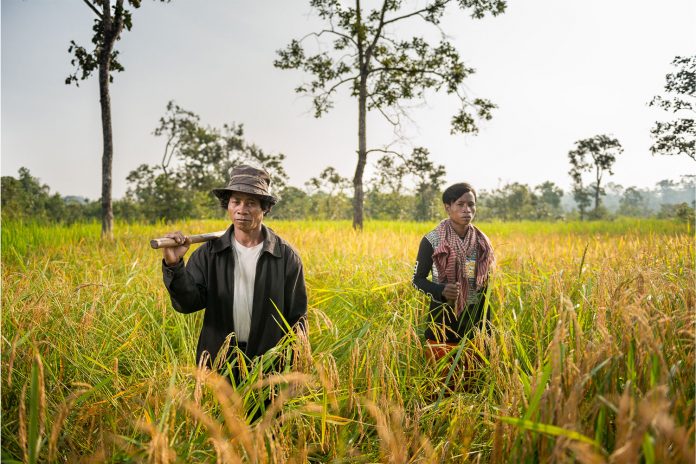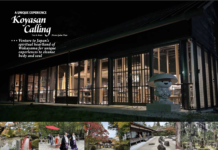A Cambodian community protects its sacred forest
Text Clothilde Le Coz/The Ruom Collective
Photos Antoine Raab/The Ruom Collective
A spirited mandate
One of the largest ethnic groups in Cambodia, the Kuy community lives in harmony with the forest. For them, life follows the organic rhythm of Nature, rooted in the essence of community life. “We call this place our home. This is where we feel protected,” they explain. A community strongly tied to their animist beliefs, the Kuy people says that the Neaktah – or ancestral spirits – have blessed their presence in the forest. The Neaktah watch over people and places, as long as they are paid respect through prayers and offerings.

Saom Than, a 48-year-old farmer, explains that the Neaktah ensure safety for the people by warding off imminent threats. “They always provide for the people. We can find fruits when we are hungry, and we do not have to worry about wild animals,” he says.
In the Kuy dialect, Prey Lang means “our forest”. For the community, this is home; they have been living here for at least two decades. More than a spiritual place, the forest is also “a nurturing mother”. This is how Hon, a 50-year-old farmer, explains it: “We have a deep connection with the forest because we look for its natural products.”
The Kuy people pay homage to the forest for providing them with resources, blessing the community with farmlands, food, medicine, rattan, vines, and other natural gifts that the villagers can use and rely on. This is how the Kuy community has been self-sufficient for the past two generations.

Also a resin tapper, Hon learnt the practice from his parents, and is now passing the trade on to his 23-year-old son, Keuth, every week, as they venture deeper into the forest to collect the precious extract. “Resin is the main source of income for our community,” he says. But yields have declined over the past eight years, and the community has observed a change in rainfall. “Before, there were more trees and the rain was regular. If this year stays dry, we will collect less resin,” Hon says. He believes that this is because of illegal logging.
A Vanishing Point
Spanning four provinces and covering 3,600 square kilometres, Prey Lang is considered the largest evergreen forest in the country, and is likely the most expansive in Indochina. But over the last 10 years, Cambodia’s deforestation rate has increased more rapidly than that of any other country in the world.
A recent report published through a collaboration of NGOs – the MOSAIC Project, CHRTF, N1M and Mother Nature Cambodia – states that the Cambodian government granted at least 32 economic land concessions (ELCs) in Prey Lang, “clearing spirit forests and graveyards without concern”. The report also reveals that a forest “restoration project is found to be clear-cutting dense, valuable forest and transforming it into a monocrop acacia plantation”.
For Fran Lambrick, a British environmental scientist who has been studying the Prey Lang forest for five years, concessions are a vehicle for deforestation.
“When companies come for the land, they start clearing the forest and exploiting valuable timber, even outside the concession boundary. There are all kinds of corruption that help make it happen,” she says.
Scientists estimate that deforestation is responsible for up to one-sixth of global carbon emissions, which contribute to warmer temperatures. As deforestation is responsible for 19 percent of greenhouse gas emissions released into the atmosphere each year, the country has also been driving climate change.
The United Nations estimates that the loss of Prey Lang would not only have an impact on the climate, but would also affect at least 1.5 million people in the Mekong region.
“Prey Lang has valuable ecological importance [and its] ecosystem plays a critical role in the water regulation between the Tonle Sap and Mekong basins,” a representative of the UN Development Programme (UNDP) in Phnom Penh explains. The Tonle Sap is one of the world’s most productive freshwater ecosystems – so productive, in fact, that it has earned the lake the nickname of “Cambodia’s beating heart”.
As Prey Lang’s trees vanish due to the activities of illegal loggers, so too, the Kuy believe, do the Neaktah spirits. “If the forest dies, we die,” say many members of the community, who are fearful that the disappearing spirits will leave the Kuy people vulnerable. “Now that the forest is gone, I do not feel like I am protected anymore,” says Saom Than.
Defending their roots
Facing the need for action to stop the destruction of the forest, the Kuy people rallied together to patrol their neighbouring forest and monitor any illegal deforestation. The result of this effort is the Prey Lang Network (PLN), which was created in 2007. Comprising 339 communities spanning across four provinces, the network is reliant on funding from foreign countries and organisations to be able to coordinate patrols to catch illegal loggers.
Every other month, about 20 members of the network embark into the forest to catch illegal loggers, using acid to destroy the internal mechanisms of the chainsaws. The bigger the group, the less likely they are to encounter violence.
Hong, a 40-year-old farmer and activist, has been patrolling the forest and rallying her community to protect it. “I realised what was happening to the forest when I could not live from collecting resin anymore,” says the vivacious woman. “We had to act. This is how I joined the Prey Lang Network and start to become more active.” A mother of five, she has been relying on Prey Lang’s resources all her life.
“If we do not take care of the forest, who will?” she keeps asking. Hong knows that this fight is larger than her life, and so she keeps defending Prey Lang, one log at a time. Although the network has taken it upon itself to defend the forest, they do not have any authority to arrest the loggers or impound the wood and chainsaws.
“When wood is confiscated, we inform the local pagoda about it and everything is delivered there,” explains Hong. “We have had very bad experiences with the local authorities in the past. They never collaborate to protect the forest, even if it is their duty. The community is doing the government’s job.”
To Lambrick, their work plays an important role in raising awareness. “What the network is doing deters small loggers. But the bigger fish – the ones logging illegally for large companies – are organised differently and they treat the forest as if it is their own property,” she explains, commending the courage of the network.

In late 2015, the PLN was one of the winners of the 2015 Equator Prize, which they received in Paris. Environmental activists are often harassed by the Cambodian officials, and it is not uncommon for the members of the PLN to receive threats from local authorities.
The death of Chut Wutty, a prominent environmental activist and community mentor who was killed in 2012, stills weighs heavily on the community. In March 2016, a member of the network was attacked with a machete while he was asleep during a patrol. Environmental activists from all over Cambodia add to this ever-growing list of victims of violence, so much so that Cambodia was named one of the most dangerous countries for environmental activists by Global Witness.
Like nomadic herders, they choose a new home every night, lying under the cover of darkness to avoid detection, comforted by the belief they are protected by the Neaktah. Although their mission carries a sombre purpose, the Kuy share laughter and stories that remind them of the sovereignty of the surrounding trees. More than an environmental patrol, this mission struggles to preserve the sacred, so that ancestral Kuy practice might endure.
For more stories and photographs from the issue, see Asian Geographic Issue 123, 2017











